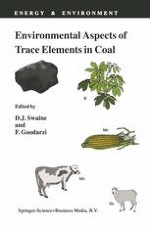1995 | OriginalPaper | Chapter
The Fate of Trace Elements in Emissions Control Systems
Author : L. B. Clarke
Published in: Environmental Aspects of Trace Elements in Coal
Publisher: Springer Netherlands
Included in: Professional Book Archive
Activate our intelligent search to find suitable subject content or patents.
Select sections of text to find matching patents with Artificial Intelligence. powered by
Select sections of text to find additional relevant content using AI-assisted search. powered by
Coal utilisation is an important source of trace-element emissions to the atmosphere (Clarke and Sloss, 1992). In a typical pulverised coal-fired power station combustion takes place in a furnace operating at temperatures above 1400°C. Coal is injected into the furnace and ignited while in suspension. As the particles are heated, volatile matter is vaporised and combustion occurs. Minerals undergo thermal decomposition, fusion, disintegration, and agglomeration. The final solid products of combustion are usually spherical ash particles, which may subsequently undergo further processes such as coalescence with other particles or expansion due to internal gas release. The formation of molten ash droplets marks the highest temperatures, and a significant fraction of the volatile forms of elements will exist in the gas phase. Some larger mineral particles may be only partly melted, and refractory minerals with high melting points may escape melting regardless of size. The main formation mechanism of coarse ash particles (> 2 µm) is carry-over of a proportion of the mineral matter in the feed coal. A portion of the non-combustible material is retained in the furnace as either slag or bottom ash. The rest of the inorganic material exits in the flue gases as flyash and vapour.
